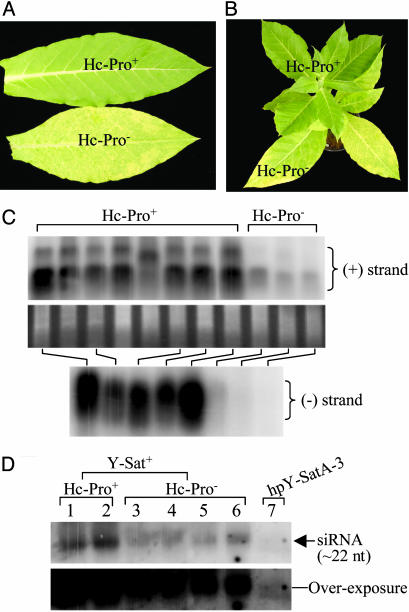Fig. 2.
Expression of Hc-Pro in tobacco dramatically reduces the yellow mosaic symptom of Y-Sat. (A) Y-Sat induces severe chlorosis in Hc-Pro- tissue but not in Hc-Pro+ tissue. The Hc-Pro+ and Hc-Pro- plants were siblings of the same F1 plant that was obtained by pollinating N. tobacum Wisconsin 38 with pollen from the previously described Hc-Pro plant (22). The presence or absence of the Hc-Pro transgene was confirmed by PCR analysis. (B) An Hc-Pro- scion in a grafted plant showed severe Y-Sat symptom, whereas the shoot from the Hc-Pro+ stock exhibited very little yellowing. (C) Detection of plus (+) strand (Top) or minus (-) strand (Bottom) of Y-Sat RNA in Hc-Pro+ and Hc-Pro- tobacco infected with Y-Sat. (Middle) RNA loading control. Twenty micrograms of total RNA was hybridized with either antisense (Top) or sense (Bottom) Y-Sat RNA probe. (D) Detection of siRNA from Hc-Pro+ (lanes 1 and 2) or Hc-Pro- (lanes 3-6) tobacco infected with Y-Sat, or uninfected tobacco transformed with the hpY-Sat construct (lane 7). Total RNA (40 μg) was hybridized with the full-length antisense Y-Sat sequence. (Lower) An overexposure of Upper. Note that the infecting Y-Sat produced at least 100-fold more siRNA than the hpY-Sat transgene; hpY-SatA-3 is the same as that in Fig. 4A, where small RNA enriched from 120 μg of total RNA was loaded.

